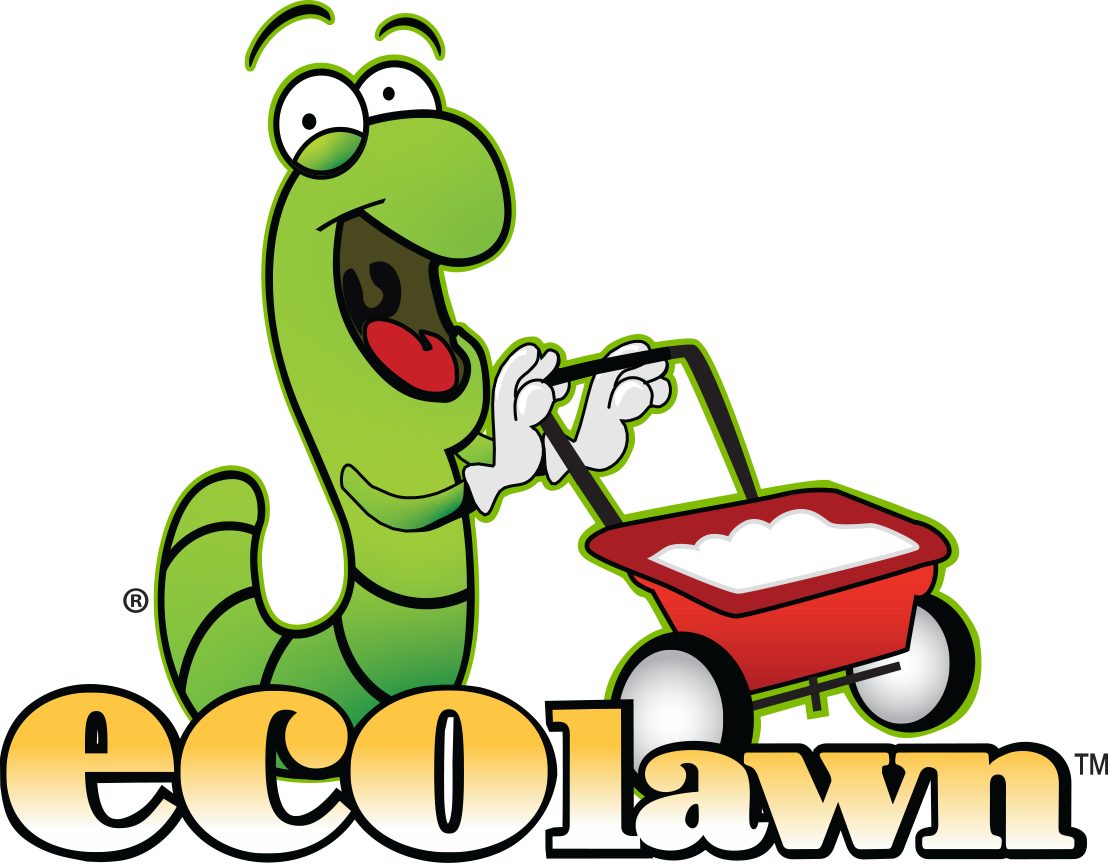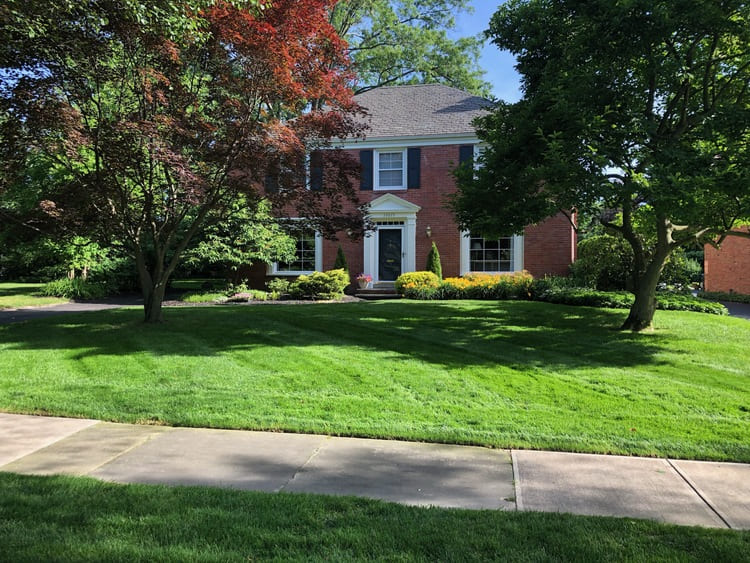Home » Uncategorized »
When to Apply Grub Control on Your Lawn in Mentor, Ohio

Every now and then, an otherwise healthy and lush lawn can give way to unsightly brown areas. The culprit behind this frustrating phenomenon could be lurking beneath the surface – lawn grubs.
These unseen enemies, the larval stage of common beetles, munch away at your grass roots, leaving your lawn weak and susceptible to damage.
In this blog, we’ll discover the secrets of the lawn grub lifecycle and show you when to apply grub control on your lawn!
The Lifecycle of Grubs
Spotting grubs or grub damage in your lawn is a good indicator of an infestation (more on this below), but understanding their complete lifecycle is key to effectively managing and eliminating grubs from your lawn.
1) Egg Laying
Adult beetles lay their eggs in the soil between June and August. In this favorable environment of warm and moist conditions, the eggs hatch within a few weeks.
2) Larvae Development
Once these grubs are hatched, the first-instar larvae emerge and feed on the grass roots. The term ‘instar’ refers to the developmental stage of the larvae between molts, and the first instar is the very first stage after they hatch. Think of it like a newborn baby that grows through different stages. At this stage, the larvae are tiny and relatively less destructive, but they still threaten your lawn because they feed on the grass roots.
Grass roots are crucial as they provide nutrients and water to your lawn. Without healthy roots, your grass can become weak and eventually die. As these grubs grow and molt into the second stage, they become larger and more aggressive in feeding. This increased feeding activity can cause visible damage to your lawn, such as brown patches or dead spots.
3) Pupae Stage
After the ground thaws in spring, the overwintered third-instar grubs transform into pupae and remain in the soil for several weeks. During this stage, they rapidly grow and transform into adult beetles. The Japanese Beetle is the most common type, and it can damage plants and trees in Ohio, such as Roses, Purple Leaf Plums, Hostas, Viburnum, and Weeping Cherries.
4) Adult Stage
The beetles emerge from their pupae near the beginning of summer. After a 2-3 week mating period, the female beetles lay around 60 eggs in the soil, restarting the cycle. Most lawn beetle species complete this lifecycle within one year, except for the June beetles, which have a three-year lifecycle.
Understanding Grub Damage
Now that you understand grubs’ different life stages, it’s important to recognize how their feeding habits affect your lawn.
Grub damage appears as large, irregularly shaped brown areas on your lawn. This damage is often confused with drought damage. However, one easy trick to differentiate them is to pull back on the affected turf areas. If grubs are the culprit, your turf will be very soft and easily pulled apart because they feed on the grass roots, making them weak and easy to pull apart.
When you pull back the turf, you will likely find grubs underneath. Sometimes, you may need to pull back more turf to see these off-white, C-shaped, and brown-at-one-end grubs.
This infestation can attract undesirable wildlife to your lawn, such as skunks, birds, and chipmunks. These animals search for a meal, and weeds can invade these areas quickly as they dig through the soil.
One of the most dreaded critters attracted to grub-infested lawns is moles. But what does this mean for you and your lawn?
The Connection Between Moles and Grubs
Contrary to popular belief, the presence of moles and grubs in your lawn is not always directly correlated. While moles do consume grubs, treating your lawn for grubs alone will not necessarily eliminate moles.
Moles primarily feed on earthworms, which account for over 90% of their diet. Although grubs and other insects such as beetles, snails, and spiders are also part of their diet, they are secondary food sources. Therefore, even if you successfully treat your lawn for grubs, moles may remain due to the abundance of earthworms and other insects.
However, grubs can attract moles to your lawn, creating unsightly tunnels as moles search for food. However, addressing a grub problem does not automatically solve a mole problem, and vice versa. Each issue must be managed separately to maintain a healthy lawn effectively.
To deal with grubs, you must use appropriate grub control treatments that target their life stages and reduce their population. For moles, different strategies, such as trapping, repellents, or professional pest control services, may be necessary to prevent them from creating tunnels and causing damage.
In summary, while moles and grubs may have some connection due to their feeding habits, they must be treated as separate issues. Understanding the distinct nature of their relationship is crucial for effective lawn care and pest management.
When to Apply Grub Control on Your Lawn
The key to effective treatment is timing the application to target grubs in their larvae development stage.
In Ohio, grub preventers should be applied in summer, from June to August, when grub eggs hatch into young larvae. At Ecolawn, our lawn care program includes our Guaranteed Grub Preventer treatment, typically applied during your second or third lawn feeding visit, which falls within this crucial timeframe. This timing prevents the grubs from developing into the more destructive later-instar stages (as mentioned above).
Applying grub control too early in spring is ineffective because the grubs are still overwintering deep in the soil, making them less susceptible to treatment. The insecticide may degrade before the grubs become active, rendering the treatment useless.
Similarly, treating too late in the fall is also ineffective. By this time, the grubs will soon burrow deep into the soil to overwinter, avoiding the insecticide altogether. Therefore, proper timing is essential for effective grub control, ensuring the treatment targets the grubs when they are most vulnerable.
Don’t Worry About Applying Grub Control – Let Ecolawn Handle It!
Knowing what to apply and when can be challenging if you’re treating your lawn yourself. Following package instructions carefully can be tough when you’re in a rush to reclaim your lawn.
At Ecolawn, we want all of our client’s lawns to thrive. That’s why our lawn care program includes our Guaranteed Grub Preventer treatment, typically applied during your second or third lawn feeding visit between June and August. Unlike other companies that may not suggest or stand behind this treatment, we guarantee you won’t experience grub damage—or it’s on us!
If you’re looking for a lawn care partner who truly cares about you and your lawn success, contact us for a complimentary consultation, or simply contact us for advice!
FOLLOW US FOR MORE LAWN CARE TIPS
Complimentary Consultation
"*" indicates required fields

